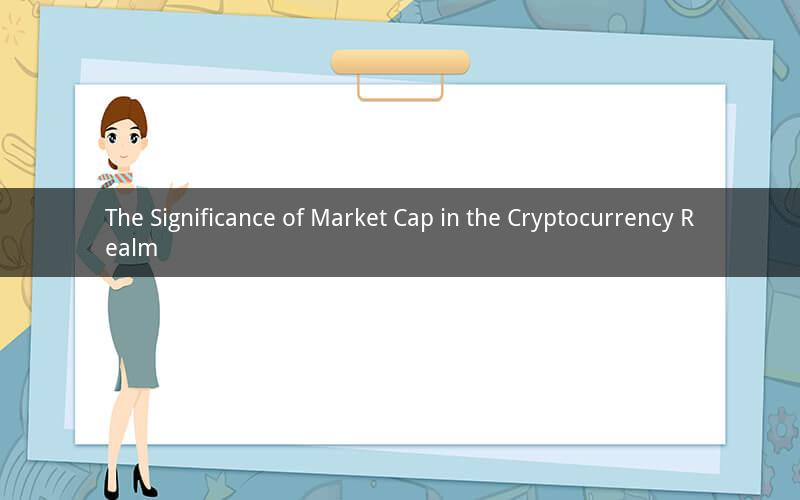
In the ever-evolving world of cryptocurrencies, market capitalization (market cap) has emerged as a pivotal metric that reflects the value and importance of a digital asset. This article delves into the reasons why market cap matters in the crypto industry, offering insights into its role, limitations, and its future implications.
Understanding Market Cap
Market cap is a measure of the total value of a cryptocurrency, calculated by multiplying the number of coins in circulation by the current market price of each coin. It serves as a gauge of an asset's liquidity and its standing within the cryptocurrency ecosystem.
The Importance of Market Cap in Crypto
1. Reflects Asset Value and Popularity
Market cap provides a clear indication of the value and popularity of a cryptocurrency. Assets with higher market caps are often perceived as more stable and trustworthy, making them more appealing to investors and traders. This perception can lead to increased demand, further boosting the asset's price.
2. Determines Investment Priorities
Investors and traders often prioritize assets with higher market caps when making investment decisions. This is because these assets are typically considered safer and more reliable. As a result, higher market cap cryptocurrencies often attract more capital, which can further solidify their position in the market.
3. Influences Market Sentiment
Market cap plays a significant role in shaping market sentiment. When a cryptocurrency's market cap increases, it can instill confidence in the market, leading to a bull run. Conversely, a decrease in market cap can trigger concerns and lead to a bearish trend. This sentiment can have a ripple effect on the entire cryptocurrency market.
4. Facilitates Liquidity
Higher market cap cryptocurrencies tend to offer better liquidity, making them easier to buy and sell without significantly impacting their prices. This liquidity is crucial for investors and traders who need to enter or exit positions quickly.
5. Aids in Comparison
Market cap allows for a straightforward comparison between different cryptocurrencies. It helps investors evaluate which assets are more valuable and which might offer better growth potential.
Limitations of Market Cap
While market cap is an essential metric, it is not without its limitations:
1. Inadequate Representation of Real Value
Market cap does not necessarily reflect the intrinsic value of a cryptocurrency. It is influenced by market sentiment, speculative trading, and external factors such as regulatory news. As a result, market cap can sometimes be misleading.
2. Volatility
Market cap is highly volatile, often fluctuating rapidly in response to market news and sentiment. This volatility can make it challenging to use market cap as a reliable indicator of an asset's value.
3. Exclusion of Real-World Applications
Market cap does not consider the real-world applications or potential of a cryptocurrency. An asset with a low market cap might offer significant value in terms of its utility or potential, while an asset with a high market cap might have limited real-world applications.
4. Ignoring the Total Supply
Market cap only considers the number of coins in circulation. It does not take into account the total supply of coins, which can be an important factor in assessing the long-term viability of a cryptocurrency.
The Future of Market Cap in Crypto
As the cryptocurrency industry continues to mature, market cap is likely to remain a significant metric. However, its role may evolve as new technologies and investment strategies emerge. Here are a few potential developments:
1. Enhanced Evaluation Metrics
Developers and investors may explore additional metrics to complement market cap, providing a more comprehensive evaluation of an asset's value and potential.
2. Increased Focus on Real-World Applications
As cryptocurrencies gain wider adoption, investors may place greater emphasis on the real-world applications and utility of an asset, rather than solely focusing on market cap.
3. Enhanced Regulatory Framework
Regulatory authorities may develop a clearer framework for assessing the value and potential of cryptocurrencies, potentially impacting the role of market cap in the industry.
4. Rise of Alternative Investment Strategies
Investors may adopt alternative investment strategies that go beyond market cap, considering factors such as tokenomics, team strength, and technological advancements.
In conclusion, market cap is a critical metric in the cryptocurrency industry, providing valuable insights into the value, popularity, and potential of a digital asset. While it is not without its limitations, market cap is likely to remain a significant factor in the crypto market for the foreseeable future.
Questions and Answers:
1. Q: What is the difference between market cap and market value?
A: Market cap is the total value of a cryptocurrency, calculated by multiplying the number of coins in circulation by the current market price. Market value refers to the overall worth of all coins in circulation, regardless of their price.
2. Q: Can a cryptocurrency with a low market cap become a significant player in the market?
A: Yes, a cryptocurrency with a low market cap can still become a significant player if it gains widespread adoption, offers innovative solutions, or attracts significant investment.
3. Q: How does market cap affect the trading volume of a cryptocurrency?
A: Higher market cap cryptocurrencies tend to have higher trading volumes, as they are more popular and liquid. This can make it easier for traders to buy and sell these assets.
4. Q: Can market cap be manipulated?
A: Yes, market cap can be manipulated through various means, such as wash trading or spoofing. This is why it is important to consider other factors when evaluating a cryptocurrency's value.
5. Q: Is market cap the only metric to consider when investing in cryptocurrencies?
A: No, market cap is just one of many metrics to consider when investing in cryptocurrencies. Other factors, such as tokenomics, team strength, and real-world applications, should also be taken into account.